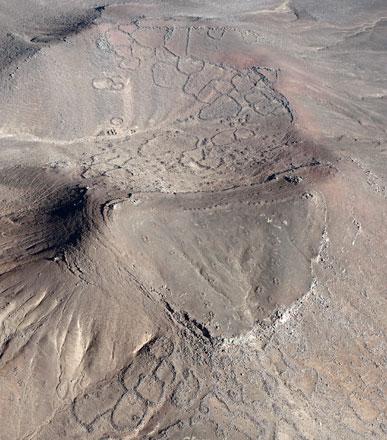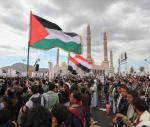You are here
‘Ancient terrace practice in Jordan a sign of innovation’
By Saeb Rawashdeh - Sep 12,2017 - Last updated at Sep 12,2017
AMMAN — A workshop titled "Ancient Terraces Practices in Jordan", was held on Sunday at the German-Jordanian University near Madaba.
The event was organised as a joint venture between the German Protestant Institute of Archaeology in Amman and the Centre for the Study of Natural and Cultural Heritage of the German-Jordanian University, with the support of the German Institute of Archaeology, the organisers said.
The workshop gathered experts in the fields of archaeology, agronomy and architecture.
"I look at this topic [ancient terraces] as very important, because that is part of understanding our history," said Director General of the Department of Antiquities Monther Jamhawi in his opening remarks.
Jamhawi, who was the official patron of the event, added that these terraces "show us how humans in the past were innovative to solve the problems they faced".
For German researcher Bernd Muller-Neuhof, from the German Archaeological Institute, the implementation of terraces for gardening, in combination with run-off irrigation, is a strategy for applying agriculture in regions with low precipitation and no access to rivers for irrigation.
This strategy has been applied by prehistoric societies in the Middle East and the southwest of the US, according to Muller-Neuhof, who for many years directed the research in northeastern badia.
One of the earliest known examples derives from the basalt desert of northeastern Jordan, where terraces have been introduced in the late 5th and the 4th millennium BC, he stressed.
The UNESCO representative, Italian architect Giovani Fontana Antonelli, highlighted the Palestinian village of Battir, which lies 7km southwest of the Old City of Jerusalem, where locals constructed terraces using the same farming methods for centuries.
“Battir’s historic rural landscape is characterised by an extensive area of handmade agricultural terraces, dry-stone walls and ancient irrigation systems that survived until today, he said.
The tool for safeguarding this cultural landscape was the “Battir Landscape Conservation and Management Plan”, Fontana Antonelli continued, adding that the plan was based on the detailed survey of 12sq.km of terraced landscape and the subsequent classification of its main typologies, which led to designate “land units”.
While surveying the runoff water retention systems built by the Nabataeans in the Beidha area, mainly inside Little Petra, the Swiss architect, archaeologist and restorer Ulrich Bellwald discovered a well-preserved, partially still backfilled and not fully excavated wine press at the eastern end of the wadi adjacent to the western end of Little Petra.
The most frightening feature which could be discovered was a dam with a height of more than 25m, closing the outlet of the wadi with the winery into Wadi Beidha below the Neolithic settlement, Bellwald said.
It was only the construction of this dam which allowed the set-up of the winery, as it tremendously reduced the gradient of the wadi bed, which finally led to the deposition of the required sediments for the plantation of the vines; hence, the wadi in its actual topography proved to be a completely artificial, manmade landscape, Bellwald claimed, noting that, after having been backfilled, the area was terraced for the plantation of the vines.
Due to the remote location of the wadi, it was never used again for any agricultural use since the Nabataean period. Therefore, even the terraces laid out for the plantation of the vines are still visible today, the expert pointed out.
According to Bellwald, the newly discovered “Little Petra Winery” is by far the most elaborate model of agriculture by terracing in the Petra area, and, furthermore, it bears witness for a long-term planning and investment in the field of agricultural production.
Catreena Hammarneh, a Jordanian archaeologist from the German Protestant Institute of Archaeology, connected ancient with modern terraces in her presentation “Human Role in Reshaping the Landscape of Ancient Terraces of Petra as Response to Environment”.
“Manmade agricultural installations are a common feature not only in Jordan, but around the Mediterranean,” she emphasised.
Mohammad Najjar, a veteran archaeologist, presented a paper Investigating two “Iron Age Agricultural Terraces in Faynan/Southern Jordan” where he analysed the potential impact of copper industrial production on the local environment.
Based on the results of these analysis it will be argued that, although persistently high, the environmental pollution caused by industrial copper production during the Iron Age was restricted to the production locales and slag heaps, and that these agricultural terraces had twofold function of minimising the heavy metal contamination and pollution of the soils, and sustaining the working on copper production, he added.
The region of Wadi Faynan is an "excellent" case study for the evolution of socio-political complexity and environmental degradation, Najjar claimed.
However, there is still a substantial amount of evidence that the valley was a place where different floodwater farming techniques were implemented, he said.
In addition, one of the biggest challenges was to date the ancient agricultural terrace systems, as there was a scarcity of material culture especially datable artefacts found during the excavations, the archaeologist said.
The workshop participants came up with a number of recommendations related to the protection of the natural heritage, and also emphasised a need of building a network of local and international specialists to work together in joint projects, organisers said.
Aims for future work could involve increased studies on terraces and their traditional patterns in order to revive traditional practices, which are imperative in order to counteract environmental threats, such as water scarcity and urban expansion at the expense of agricultural land.
Related Articles
AMMAN — Despite the harsh desert climate, the Nabataean inhabitants of ancient Petra were capable of growing different kinds of agricultural
AMMAN — Fortifications and the oldest known dam in the world built around 3,600BC are the main characteristics of Jawa,a site 60km nor
AMMAN — The irrigation system in the terraced gardens of the Black Desert, according to scholars, was probably the outcome of an indigenous


















